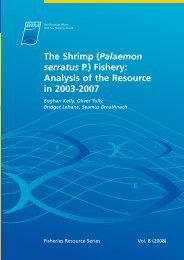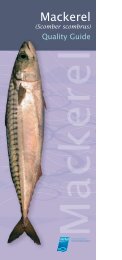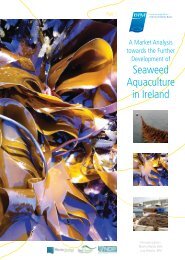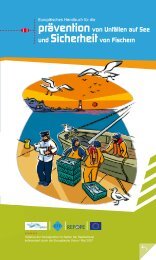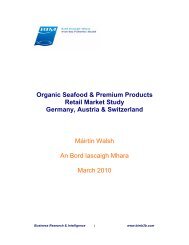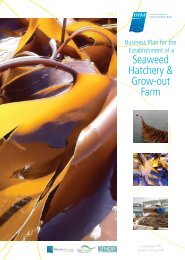Cultivating Palmaria palmata - Bord Iascaigh Mhara
Cultivating Palmaria palmata - Bord Iascaigh Mhara
Cultivating Palmaria palmata - Bord Iascaigh Mhara
You also want an ePaper? Increase the reach of your titles
YUMPU automatically turns print PDFs into web optimized ePapers that Google loves.
20<br />
storage tank, followed by fine filtering using, for example, cartridge filters (10, 5 and 1 μm pore size) and<br />
a final Ultra-Violet (UV) sterilisation unit with 2-3 UV light units in a row to kill microorganisms.<br />
Seawater treated in this way is suitable for <strong>Palmaria</strong> cultivation, including the processes of spore<br />
release and settlement, as well as cultivation of seeded material.<br />
Drainage: All on-shore aquaculture facilities require an aquaculture licence and a seawater discharge<br />
licence. Information on legal requirements can be obtained from the relevant authorities such as the<br />
Department of Agriculture, Fisheries and Food, Ireland (DAFF) in the Republic of Ireland, and the<br />
Department of Agriculture and Rural Development in Northern Ireland (DARD; see Appendix 1). Once a<br />
licence is granted, discharge activities will be monitored on a regular basis by the responsible<br />
authorities.<br />
The capacity of the drainage system needs to be carefully considered. It should be over- rather than<br />
under-sized and should cope with drainage of 1000-L tanks. In a flow-through system, a suitable<br />
capacity would be 5-10 times the overflow.<br />
Light: Light units for culture tanks are fitted with cool white fluorescent tubes providing an even<br />
illumination of tanks or areas with smaller culture vessels. The height of the light units should be<br />
adjustable or they should be connected to a dimmer so that the light intensity can be changed during<br />
cultivation. Light periods, i.e. day lengths, are controlled by timers.<br />
Air: Aeration of culture vessels is essential. Without proper aeration and the resulting movement of<br />
water around the algal culture vessels and tanks, the algal material will start to deteriorate quickly.<br />
An airblower needs to be installed in a separate, well aerated shed or separate room because it<br />
generates noise and heat. The capacity of airblower required depends on the size of the hatchery<br />
facility.<br />
From the airblower, the air is conducted to the culture room via PVC pipes. Multiple outlet sites are<br />
necessary to serve a large culture room. Therefore, the room should be fitted with a ring system of<br />
pipes with a number of outlet valves which can, in turn, be fitted with multiple outlets to which 3-4 mm<br />
tubing can be connected for aeration of the culture vessels and tanks. The diameter of the aeration pipe<br />
is progressively reduced to allow the pressure to be maintained.





